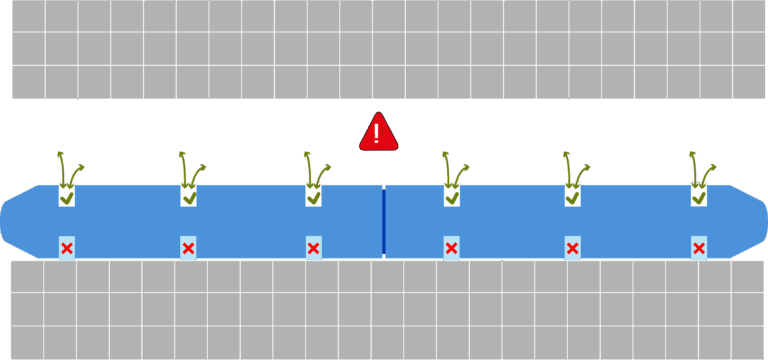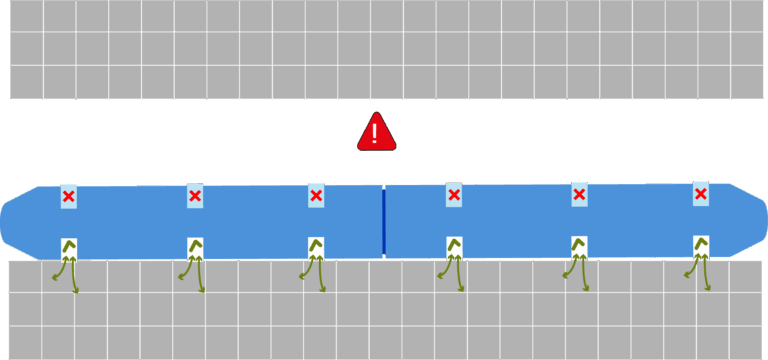ASDO: Automatic Selective Door Operation
Automatic Selective Door Operation (ASDO) is a generic product designed to deliver safer and more efficient train operations through precise, individual door control. Instead of operating doors by coach or car, ASDO manages each door independently, so that only doors aligned with the platform are released.
This precision is particularly valuable at stations with shorter platforms, allowing passengers to step only onto safe areas.
ASDO also incorporates Correct Side Door Enabling (CSDE), activating only the doors on the side adjacent to the platform.
Certified to SIL 2, ASDO offers a proven level of safety and reliability. As a vendor-independent solution, this generic product can be used with any Train Control and Management System (TCMS) and is suitable for both new builds and refurbishment projects.



ASDO for improved passenger experience
Without ASDO, some doors that align with the platform may remain closed, requiring passengers to board or exit through other trainsets. Manual door selection also carries the risk of opening the wrong doors.
These challenges are eliminated by ASDO which can automatically determine the train’s position and platform configuration, ensuring that only the correct doors open. This enhances passenger convenience and improves overall operational safety.
Correct Side Door Enabling (CSDE):
Enable doors on the platform side only
Correct Side Door Enabling (CSDE) is a critical safety feature integrated into the ASDO system. Its purpose is to ensure that train doors only open on the side adjacent to the platform, preventing accidental door activation on the wrong side.
When the train stops at the designated position, CSDE activates only the doors facing the platform. This controlled operation enhances passenger safety, minimises operational errors, and supports compliance with industry standards such as RIS-2747-RST.
CSDE is fully integrated within the ASDO architecture and operates without reliance on external inputs, such as timetables or Train Control and Monitoring System (TCMS) data. It can function independently or alongside infrastructure elements, such as track-mounted balises, to provide flexible deployment.


Build ASDO using the following modules
The ASDO system usually consists of two Central Processing Units (CPU), I/O modules, power supplies and a rack. Click on an image to explore related content.
Modular Concept
Below is an example of an ASDO system made up of a selection of common modules. The modules are the minimum required for ASDO, with additional modules available for expanded functionality. For example, HABD is often integrated within the same system. Hover over each area to view a brief description or click to access the full module page.

CPU with Graphical Display Controller (CPG)
Supports DVI and Ethernet display interfaces
Power Supply Unit for VME (PSV)
Provides power for the ASDO HMI
Vehicle Identification Unit (VIU)
Required for door identification for the HMI.
CPU with Serial Links (CPS)
A central processing unit providing serial communication interfaces.
Digital Input Output Module (DIO)
A Digital Input Output Module for delivering digital ASDO signals to the ASDO CPU modules.
High Speed Analogue Input Module (HSA)
Converts analogue signals and makes them available to the ASDO CPU modules.
Power Supply Unit for VME (PSV)
A second power supply unit required to power the ASDO system
Vehicle Identification Unit (VIU)
A second VIU required for door identification for the ASDO System
Application Software
The ASDO application software is built on an open-source Linux platform and is coded in C and C++.
Unlike our TCMS platform, which allows users to code their own applications, ASDO application software is built by EKE-Electronics. This protects the SIL 2 certification which requires tools. processes and knowledge about how to produce SIL Safety applications.
ASDO Station Database
The Automatic Selective Door Operation solution includes the ASDO Station Database, containing essential infrastructure details like stations and platforms. This database builds the “station network” for Automatic Selective Door Operation usage and can be easily updated by operators to reflect changes such as track renewals, new routes, or stopping patterns.
For traceability, the database has its own version control system, allowing operators to verify the current version directly from the ASDO HMI maintenance screen.
Positioning Solutions
ASDO offers a range of positioning solutions to suit different operational needs.

Our odometry-based system accurately measures distance by tracking wheel rotations, ensuring precise movement tracking.

The beacon-based system leverages trackside beacons to provide reliable location data, particularly in complex rail environments.

Combining odometry with GNSS, our hybrid solution is a cost effective solution. However, the use of GNSS is not SIL 2 certified.
Odometry is the most cost-efficient solution as it does not require additional infrastructure. While beacon-based positioning offers increased accuracy, installation can be expensive. To reduce the cost impact, beacons can be selectively placed in key locations, such as complex stations, and combined with odometry to maintain a SIL 2-certified solution.
Intuitive ASDO User Interface
The ASDO Human-Machine Interface (HMI) plays a key role in providing essential door and station information to the crew. Designed for clarity and ease of use, it ensures seamless interaction with the system, enabling efficient train operations and informed decision-making.
As the train approaches a station, the display shows the next stop and the assigned arrival platform. If a change is needed, the crew can update this information using the change button.
The system cross-references the train’s determined location with the ASDO Station Database. Safe-to-open doors are highlighted in blue on the screen, while a map pin clearly marks the front of the train. If necessary, the crew can override the door configuration from this interface.
For maintenance and diagnostics, dedicated screens allow technicians in the depot to configure wheel diameter, monitor ASDO status, verify software versions, and perform troubleshooting.


How does ASDO work?
The Automatic Selective Door Operation system begins by verifying the platform configuration to ensure that doors open only at the correct locations. It uses odometry, in conjunction with GNSS and data from the ASDO Station Database, to locate the train and identify the station. This information determines the number of doors to open and on which side(s) of the train. If necessary, balises or beacons can also be utilised.

ASDO Options
ASDO has a number of options available to add greater functionality to your system.
The ASDO Visualisation Tool enhances the functionality of the ASDO Station Database tool by introducing an interactive map feature. This feature allows users to visualise various objects within the ASDO Station Database, including Stations, Reset Points, and Segments.
A user-friendly graphical interface simplifies the process of editing the ASDO Station Database. It utilises OpenStreetMap Online for navigation and editing capabilities.
EKE-Electronics offers the following variants of ASDO:
- Selective Door Operation: The crew manually selects the doors that can be safely opened.
- Correct Side Door Enabling (CDSE): Ensures safe passenger access by opening only the doors on the correct side of the train at designated locations. The system supports three operating modes: manual, semi-automatic, and fully automatic door operation. To determine the correct side and location, CSDE relies on trackside beacons, the Global Navigation Satellite System (GNSS), and distance measurement.
Why Choose EKE-Electronics for your ASDO?
Benefit from our unparalleled expertise, backed by the successful installation of over 2,000 Automatic Selective Door Operation systems across multiple countries. Our extensive experience ensures reliable performance and exceptional quality, making us the trusted choice for efficient and safe door operation solutions.

Leveraging our wealth of experience and a comprehensive process adhering to standards such as EN 50126/50128/50129/50716, we have established a robust framework for developing and testing safety applications. Customers can be assured of a dependable solution that prioritises safety without compromising on performance.

We offer multiple Automatic Selective Door Operation options to address diverse needs. Automatic Selective Door Operation utilises odometry with GNSS, balises/beacons and odometry. This flexibility allows us to adapt to various operational scenarios, recognising our customers’ unique preferences and constraints.

Our Automatic Selective Door Operation solution retrofits older trains, extending their lifespan and integrating new door safety solutions without the need for a new door system or requiring new train purchases. This can be part of fleet modernisation/refurbishment programmes.
Automatic Selective Door Operation can also be used as part of the European Train Control System (ETCS).




